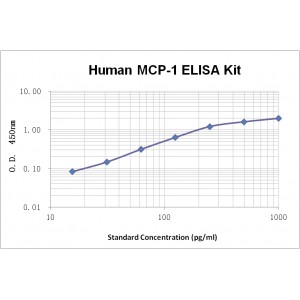More info
Assay Range | 15.6--1000 pg/mL |
Sensitivity | 1.0 pg/mL |
Specificity | No cross-reaction with other related substances detected |
Size | 96T |
Storage | Store at 2 - 8ºC. Keep reconstituted standard and detection Ab at -20 ºC |
Assay Principle | Sandwich ELISA |
Sample Volume | 100 µL final volume, dilution factor varies on samples |
Sample Type | serum, plasma or cell culture supernatant |
Detection Method | Chromogenic |
Kit Components
1. Recombinant Human MCP-1 standard: 2 vials
2. One 96-well plate coated with Human MCP-1 Ab
3. Sample diluent buffer: 12 ml— 2
4. Detection antibody: 130 µL, dilution 1:100
5. Streptavidin-HRP: 130 µL, dilution 1:100
6. Antibody diluent buffer: 12 mL x1
7. Streptavidin-HRP diluent buffer: 12 mL x1
8. TMB developing agent: 10 mL x1
9. Stop solution: 10 mL x1
10. Washing solution (20x): 25 mL x1
Background
Monocyte Chemotactic Protein-1 (MCP-1), also known as CCL2, MCAF and TDCF, is a heparin-binding small protein belonging to the C-C motif chemokine family. Human MCP-1 cDNA encodes a 99 amino acid (aa) precursor consisting of a 23 aa signal peptide and a 76 aa mature protein with a receptor binding and dimerization N-terminus and a glycosaminoglycan (GAG)-binding C-terminus. Mature human MCP-1 is 57% aa identical to the mouse ortholog (JE). Multiple proteolytically processed isoforms of MCP-1, such as the N-terminally truncated forms of 71aa and 72aa, as well as the c-terminally truncated form of 69aa.
MCP-1 is secreted by many different cell types, including endothelial cells (EC), monocytes, fibroblasts, vascular smooth muscle cells, mast cells, and astrocytes. The MCP-1 receptors are three G-protein-coupled receptors: CCR2, CCR4 and D6/CCBP2. Primarily, MCP-1 plays a chemotactic role in monocytes and basophils. Clinically, CCL2 has been implicated in pathogeneses of several diseases characterized by monocytic infiltrates, such as psoriasis, rheumatoid arthritis and atherosclerosis.


